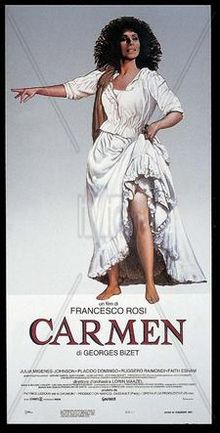
The “Les Voici” chorus from Bizet’s opera Carmen, which takes place in Act IV as the bullfighters parade into town, makes a fine addition to a choral concert. The hero of the day is Escamillo, the “espada, la fine lame” (“The Matador, the skilled swordsman”), who first appeared in the opera back in Act II, when he and his fellow bullfighters visited the inn where Carmen was drinking and dancing. Escamillo was quite smitten with her at the time, but she had other fish to fry, namely the soldier Don Jose.
Haven’t we all known someone like Carmen? All the guys are after her and yet she herself is untouched. Her heart is never fully engaged. She tells us this herself in her famous “Habanera”–”Love is a rebellious bird that none can tame.” For Carmen, it is all about the thrill of the chase: “If you do not love me, I love you.” She is quickly bored, always ready to move on to the next lover; she’s a female Casanova. It’s fair to say that she has only one great love in her life: herself.
As long as her lovers are as footloose and fancy free as she is, all is well. She can garner admiration and passion and then move on. But the danger comes when someone takes her seriously, and that someone is Don Jose. What she considers to be a harmless flirtation he takes very much to heart. He ends up getting himself into more and more trouble because of her, deserting both the army and the kind, gentle girl from back home, Micaela, and in the end he kills Carmen.
I have some very happy memories of this opera. But first a funny one. My mother used to sing me to sleep with a certain tune using the words: “Loo loo la loo loo, loo loo loo loo loo.” It was very soothing and carried with it a nice association with her. Imagine my surprise years later when I heard Carmen for the first time and realized that my mother had actually been singing the “Toreador Song”! (This piece occurs when Escamillo the bullfighter makes his first appearance in the opera and also meets Carmen.) I have no idea why she was using the melody from a song about the glories of bullfighting as a lullaby. It was just a part of our family’s private phraseology, like my father saying “Baloney in the purest form yet devised” to describe anything he found particularly nonsensical, usually in the realm of politics. When I went to college and we did declamations in speech class, suddenly I was hearing those words in a slightly different form from General Douglas MacArthur’s farewell address to Congress: “human liberty in the purest form yet devised.” My father was a great admirer of Gen. MacArthur, and that phrase apparently got stuck in his mind but used in a very different context.
Back to Carmen. Two performances stand out for me: one in the theater at the base of the Parthenon in Athens in 1977, during the same trip where I saw Aida in Rome. Quite a cultural excursion, eh? What I remember most clearly is Micaela’s aria from Act III, when the hometown girl is alone in the mountains hunting for Don Jose in order to bring him back from the brink. (Of course she fails.) As I recall, the Carmen that night wasn’t all that great, but there was stomping and shouting for Micaela. The other performance is the 1984 filmed version with Placido Domingo and Julia Migenes. I have to say that Migenes truly captured the essence of Carmen—rather elfin and playful, yet very conscious of her power over men, never taking anything or anyone too seriously—until the very end, when she is forced to do so. I’ve seen a number of Carmens, but most of them were may too serious about the whole thing. Hey, Carmen works in a cigarette factory and gets into a knife fight with another girl! She’s down with the smugglers. She reads Tarot cards. (Those she takes seriously.)
Migenes became famous in the opera world when she got the cliched call at the last minute to substitute for the star in a 1980 televised “Live from the Met” performance of Alban Berg’s Lulu. I remember seeing an interview with her after the success of the Carmen film in which she told the story of that night. Teresa Stratas was supposed to sing the role and Migenes was the understudy. Stratas was apparently known for canceling at the last minute, but I don’t think anybody thought she’d do it on such an important night. Well, she did, and Migenes’ number was called. She was at home, somewhere in the outer boroughs of New York City, and she had to get all the way downtown. The cab she took was crawling through the heavy traffic. They were never going to make it on time. She spotted a subway station and got out of the taxi. The lines at the station were long, but she got to the front by telling people she was pregnant. (Which she was—four months, as I recall.) She said in the interview that she didn’t know if people would believe her or be impressed by her saying that she had to get to the Met to sing the lead, so she fell back on the pregnancy line. It worked, she got there, they only had to hold the curtain for a short time, she went on and was a triumph. Most of her career up to that point had been in musical theater and not opera, but that performance put her on the map and surely led to her casting in the Carmen film.
Did she go on to a long career in opera? Actually no. She went off and did other things that interested her, including the performance of her own songs. In fact, I think it’s fair to say that Migenes is very much a real-life Carmen in that she has consistently refused to do the conventional thing. She’s also been divorced four times, for what it’s worth. (If you’d like to read a fascinating article about her, here’s the link: ”Reunion: Julia Migenes.”)
One last topic in this rather lengthy post: bullfights. “Les Voici” portrays the people of the town welcoming the bullfighters who are going to perform in the ring. There are several terms that need explaining:
1. “quadrille”–the entire group of bullfighters.
2. “picador”–the man who jabs the bull with a lance during the first part of the bullfight ritual.
3. “banderilleros”–men who insert the barbed sticks into the bull’s shoulders during the second part of the bullfight.
4. “toreador”–a general name for bullfighters.
5. “chulos”–cocky or arrogant ones
6. “alguazil”–the sheriff or mayor, whom the street urchins don’t like very much.
When my husband and I went on a month-long trip to Europe in 1993 we decided to attend a bullfight in Seville, which supposedly had the most traditionally-correct format. I had read Hemingway’s Death in the Afternoon and was particularly concerned about the use of horses in the ring who were often terribly injured by the bulls. I will spare you the details Hemingway used; suffice it to say that the horse’s abdomen seemed to be a favorite target. By the time of our trip, though, the horses were wearing protective armor. As the horse galloped around the ring the bull made a pass at it; I shrieked or squeaked or something, and the nice Spanish gentleman sitting next to me leaned over to Jim and said, “Es nerviosa.” Yes, I was indeed nervous. That’s a funny memory of the experience, but I’d have to say that the actual killing of the bulls was pretty gruesome. Again, I will spare you the details, but there was a lot of blood involved. (A line from Escamillo’s song says, “the arena is full of blood,” which isn’t much of an exaggeration.)
Try not to think too much about the fate of the poor bulls (and of Carmen herself) as you listen to this rousing selection! I haven’t been able to find any good clips online from the film, but here’s another fully-staged version:
And a great choral performance:
And Escamillo’s “Toreador Song”:
© Debi Simons

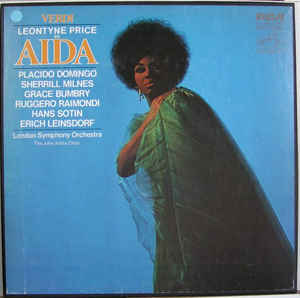
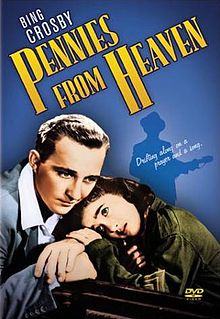
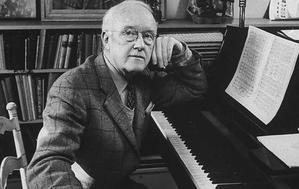
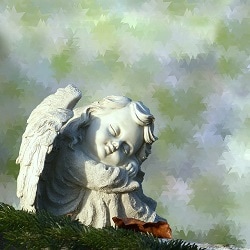
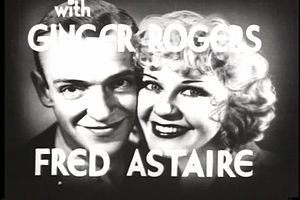 If my choir is performing a song from a film or play I always like to put the piece in context, which often means that I have to wade through summaries of plots that make very little sense. Many if not most musical comedies have plots that are simply frameworks, often flimsy, to hang the song-and-dance numbers on. (It’s okay for me to end that previous sentence with a proposition since one of these song titles does that, too.) Also, sometimes the musical numbers have outlived the production for which they were written and it’s very difficult to get access to the original story.
If my choir is performing a song from a film or play I always like to put the piece in context, which often means that I have to wade through summaries of plots that make very little sense. Many if not most musical comedies have plots that are simply frameworks, often flimsy, to hang the song-and-dance numbers on. (It’s okay for me to end that previous sentence with a proposition since one of these song titles does that, too.) Also, sometimes the musical numbers have outlived the production for which they were written and it’s very difficult to get access to the original story.
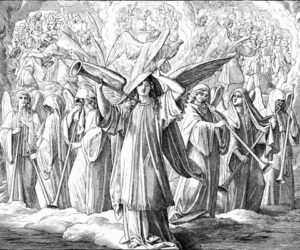
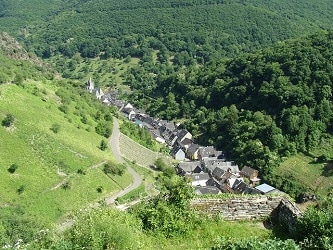 I’m sure I sang “Down in the Valley” in grade school, and I know I’ve had a picture in my mind of someone on the edge of a cliff overlooking a valley, lying face down and literally hanging her head over the edge, with her hair falling over her face and blowing in the breeze. (I guess I always thought it was “her” since I pictured long hair.) The image seemed pretty strange to me. Why would anyone do that?
I’m sure I sang “Down in the Valley” in grade school, and I know I’ve had a picture in my mind of someone on the edge of a cliff overlooking a valley, lying face down and literally hanging her head over the edge, with her hair falling over her face and blowing in the breeze. (I guess I always thought it was “her” since I pictured long hair.) The image seemed pretty strange to me. Why would anyone do that?